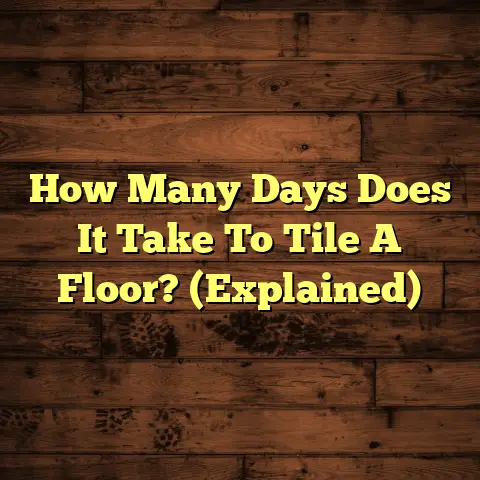Brazilian Cherry (3 Problems To Consider!)
Brazilian Cherry, also known as Jatoba, is a knockout.
I’ve seen it transform homes from drab to fab with
its rich, reddish-brown hues and incredible hardness.
Clients often gush about its exotic look and how it seems to resist everything – from scratches to the daily wear and tear of family life.
And it’s true.
It’s naturally resistant to insects and
can last for generations.
But here’s the thing:
like any high-maintenance beauty, it’s got secrets.
Before you jump on the Brazilian Cherry bandwagon,
let’s chat about some potential headaches.
I’m talking about the stuff the brochures don’t tell you.
I want you to be armed with the real deal before you
make a decision.
Because while Brazilian Cherry can
be a stunning addition to your home, it’s not always a walk in the park.
Section 1: Susceptibility to Environmental Changes
Okay, let’s get real about humidity.
Brazilian Cherry hates it when things get too moist
or too dry.
It’s like that friend who’s always complaining
about the weather.
This wood is a natural product, and it reacts to its
environment.
Think of it like a sponge; it absorbs and
releases moisture.
When humidity spikes, Brazilian Cherry absorbs that
moisture and expands.
When it’s dry, it releases
moisture and shrinks.
This constant dance of expansion
and contraction can wreak havoc on your floor.
The Warping and Splitting Nightmare
What happens when wood expands and contracts?
Well, it can warp.
I’ve seen it firsthand: beautiful,
smooth planks turning into mini-rollercoasters.
And splitting?
Oh, that’s even worse.
Imagine those
tiny cracks turning into gaping canyons between your
planks.
Not a pretty sight, trust me.
Gaps are another common issue.
During dry winter months,
you might notice spaces appearing between your boards.
It’s not because your floor is haunted; it’s just the wood
doing its thing.
- Warping: Planks lose their flat, even surface, creating an uneven floor.
- Splitting: Cracks form along the grain of the wood, compromising its structural integrity.
- Gapping: Spaces appear between planks, creating unsightly gaps and potential tripping hazards.
These issues aren’t just cosmetic.
Warped floors can be
noisy and uncomfortable to walk on.
Splits can trap dirt
and debris, making cleaning a nightmare.
And gaps?
Well, they can lead to drafts and even attract insects.
The Climate Factor: A Real-World Example
I once worked on a project in Denver, Colorado.
The client was obsessed with Brazilian Cherry.
I tried to warn her about the dry climate, but she was set on it.
We installed the floor, acclimating it as best as we could.
But within the first year, we started getting calls.
Gaps, warping, the whole shebang.
Denver’s dry climate was pulling moisture out of the wood
faster than we could replace it.
We ended up having to
do some major repairs and install a whole-house humidifier.
Acclimatization: Your First Line of Defense
Here’s the good news: you can mitigate some of these
problems with proper acclimatization.
This means letting
the wood adjust to your home’s environment before you install it.
Think of it as introducing the wood to its new home slowly.
You want it to get used to the temperature and humidity
levels before it’s nailed or glued down.
I usually recommend leaving the wood in the room where it will be installed for at least a week, sometimes longer, depending on the climate.
Here’s a quick guide:
Pro Tip: Use a moisture meter to check the wood’s
moisture content before installation.
You want it to be
within the range recommended by the manufacturer.
Homeowner Horror Stories: The Unfiltered Truth
I’ve heard some real doozies from homeowners who weren’t prepared for the challenges of Brazilian Cherry.
One client in Florida told me her floor looked like a
“rollercoaster” after a particularly humid summer.
Another in Arizona said her gaps were so big she could
“lose a small child” in them.
Okay, maybe not a child, but you get the idea.
These stories aren’t meant to scare you, but to illustrate the importance of understanding your local climate and taking preventative measures.
What the Experts Say
According to the National Wood Flooring Association (NWFA), “Proper acclimatization is crucial for the long-term performance of any wood floor.”
They recommend working with a qualified installer who understands the specific needs of Brazilian Cherry.
Section 2: Maintenance and Care Requirements
Let’s talk maintenance.
Brazilian Cherry is beautiful,
but it needs some TLC to stay that way.
Think of it as a luxury car; you can’t just drive it and
forget about it.
You need to keep it clean and polished.
The Scratch Factor
Despite its hardness, Brazilian Cherry isn’t invincible.
It can still scratch, especially from pets, furniture, and everyday foot traffic.
Here’s the deal: Brazilian Cherry has a Janka hardness
rating of around 2350.
That’s pretty darn hard, but it’s
not scratch-proof.
Think of it this way: diamonds are the hardest substance on earth, but they can still be scratched.
Preventing Scratches: Your Game Plan
- Rugs: Use rugs in high-traffic areas like hallways and living rooms.
- Furniture Pads: Put felt pads under all furniture legs.
- Pet Care: Keep your pets’ nails trimmed.
- No Shoes: Encourage people to remove their shoes at the door.
The Cleaning Conundrum
Cleaning Brazilian Cherry requires a delicate touch.
You can’t just grab any old cleaner and go to town.
You need to use products specifically designed for hardwood floors.
Here’s what not to do:
- Don’t use harsh chemicals: Bleach, ammonia, and other harsh chemicals can damage the finish.
- Don’t use abrasive cleaners: These can scratch the surface.
- Don’t use too much water: Excessive water can seep into the seams and cause warping.
Here’s what to do:
- Use a pH-neutral hardwood floor cleaner: These are gentle and won’t damage the finish.
- Use a microfiber mop: Microfiber mops are great for picking up dirt and dust without scratching the floor.
- Dust regularly: Dusting helps prevent scratches and keeps the floor looking its best.
My Cleaning Routine:
I usually recommend sweeping or vacuuming the floor
every day to remove loose dirt and debris.
Then, once a
week, I use a damp microfiber mop with a pH-neutral cleaner.
Pro Tip: Always test the cleaner in an inconspicuous area first to make sure it doesn’t damage the finish.
The Refinishing Reality
Even with the best care, Brazilian Cherry floors will
eventually need to be refinished.
This is the process of
sanding down the old finish and applying a new one.
Refinishing can restore the floor to its original glory and remove scratches, dents, and other imperfections.
How Often Should You Refinish?
It depends on the amount of traffic the floor gets.
In general, I recommend refinishing every 7-10 years.
The Cost of Refinishing:
Refinishing can be expensive, but it’s usually cheaper than
replacing the entire floor.
Expect to pay anywhere from
\$3 to \$8 per square foot.
Long-Term Costs: The Big Picture
When you’re considering Brazilian Cherry, you need to think about the long-term costs of maintenance and repair.
- Cleaning Supplies: You’ll need to buy specialized cleaners and mops.
- Repairs: You might need to repair scratches, dents, or gaps over time.
- Refinishing: You’ll need to refinish the floor every 7-10 years.
According to HomeAdvisor, the average cost of maintaining hardwood floors is \$200-\$500 per year.
Neglecting Proper Care: The Downward Spiral
If you neglect proper care, your Brazilian Cherry floor
will deteriorate quickly.
Scratches will become more
noticeable, the finish will become dull, and the wood
will become more susceptible to damage.
This can lead to more expensive repairs down the line, and eventually, you might have to replace the entire floor.
Section 3: Cost and Availability Concerns
Let’s talk money.
Brazilian Cherry isn’t the cheapest
flooring option out there.
It’s a premium wood, and
the price reflects that.
The Initial Investment
The cost of Brazilian Cherry flooring can vary depending on
the grade, thickness, and finish.
In general, you can
expect to pay anywhere from \$8 to \$15 per square foot for the wood itself.
Installation costs can add another \$3 to \$8 per square foot.
So, for a 1,000 square foot floor, you could be looking at
a total cost of \$11,000 to \$23,000.
Breaking Down the Costs:
- Wood: \$8-\$15 per square foot
- Installation: \$3-\$8 per square foot
- Materials (underlayment, adhesives, etc.): \$1-\$3 per square foot
Factors Affecting Price:
- Grade: Higher grades of wood will have fewer imperfections and will be more expensive.
- Thickness: Thicker planks will be more durable and will cost more.
- Finish: Pre-finished floors will be more expensive than unfinished floors.
Brazilian Cherry vs. the Competition: A Cost Comparison
Let’s see how Brazilian Cherry stacks up against other popular hardwood flooring options:
As you can see, Brazilian Cherry is on the higher end of
the price spectrum.
Oak and maple are more affordable
options, but they don’t have the same exotic look or hardness.
Availability and Sustainability: The Supply Chain Story
Brazilian Cherry is sourced from South America, primarily
Brazil.
This means it has to be shipped across the world,
which can impact its availability and price.
Supply Chain Issues:
Global events, such as pandemics or trade disputes, can disrupt the supply chain and make it harder to get Brazilian Cherry.
Sustainability Concerns:
The harvesting of Brazilian Cherry can have a negative
impact on the environment if it’s not done sustainably.
Deforestation and illegal logging are major concerns in
the Amazon rainforest.
What to Look For:
- FSC Certification: Look for wood that is certified by
the Forest Stewardship Council (FSC).
This means it was harvested in a sustainable manner. - Responsible Sourcing: Ask your supplier about their
sourcing practices.
Make sure they’re working with reputable companies that are committed to sustainability.
The Impact of Demand on Pricing:
As demand for Brazilian Cherry increases, the price can go up.
This is especially true if there are supply chain disruptions or sustainability concerns.
Expert Opinions:
According to a report by the World Wildlife Fund (WWF), “Sustainable forestry practices are essential for protecting the Amazon rainforest and ensuring the long-term availability of valuable hardwoods like Brazilian Cherry.”
Market Research Data:
A study by Grand View Research found that the global
hardwood flooring market is expected to grow at a rate of
4.5% per year through 2027.
This increased demand could
put pressure on the supply of Brazilian Cherry and drive up prices.
Conclusion
So, there you have it.
Brazilian Cherry is undeniably
stunning, but it’s not without its quirks.
We’ve talked about its sensitivity to humidity, the maintenance it demands, and the cost and availability considerations.
It’s like dating someone who’s incredibly attractive
but also high-maintenance.
You have to decide if the
beauty is worth the effort.
Before you take the plunge, ask yourself these questions:
- Do I live in a climate with stable humidity levels?
- Am I willing to commit to regular cleaning and maintenance?
- Is my budget realistic for the initial cost and long-term upkeep?
If you answered “yes” to all of those questions, then Brazilian Cherry might be the perfect flooring choice for you.
But if you have any doubts, it’s worth exploring other options.
There are plenty of beautiful and durable hardwood floors
that are easier to care for and more budget-friendly.
Ultimately, the decision is yours.
Just make sure you’re
making an informed one.
Don’t let the allure of Brazilian
Cherry blind you to its potential drawbacks.
Do your research, talk to a professional, and weigh the
pros and cons carefully.
Your feet (and your wallet) will thank you for it.





